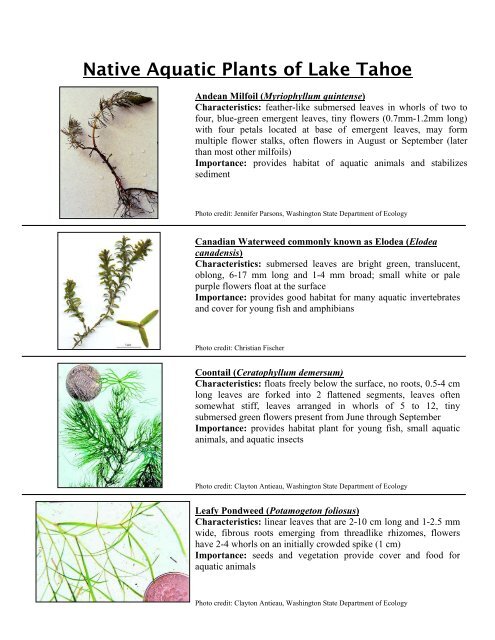Native vs. Invasive Aquatic Plant Identification Key
Native vs. Invasive Aquatic Plant Identification Key Native vs. Invasive Aquatic Plant Identification Key
Native Aquatic Plants of Lake Tahoe Andean Milfoil (Myriophyllum quintense) Characteristics: feather-like submersed leaves in whorls of two to four, blue-green emergent leaves, tiny flowers (0.7mm-1.2mm long) with four petals located at base of emergent leaves, may form multiple flower stalks, often flowers in August or September (later than most other milfoils) Importance: provides habitat of aquatic animals and stabilizes sediment Photo credit: Jennifer Parsons, Washington State Department of Ecology Canadian Waterweed commonly known as Elodea (Elodea canadensis) Characteristics: submersed leaves are bright green, translucent, oblong, 6-17 mm long and 1-4 mm broad; small white or pale purple flowers float at the surface Importance: provides good habitat for many aquatic invertebrates and cover for young fish and amphibians Photo credit: Christian Fischer Coontail (Ceratophyllum demersum) Characteristics: floats freely below the surface, no roots, 0.5-4 cm long leaves are forked into 2 flattened segments, leaves often somewhat stiff, leaves arranged in whorls of 5 to 12, tiny submersed green flowers present from June through September Importance: provides habitat plant for young fish, small aquatic animals, and aquatic insects Photo credit: Clayton Antieau, Washington State Department of Ecology Leafy Pondweed (Potamogeton foliosus) Characteristics: linear leaves that are 2-10 cm long and 1-2.5 mm wide, fibrous roots emerging from threadlike rhizomes, flowers have 2-4 whorls on an initially crowded spike (1 cm) Importance: seeds and vegetation provide cover and food for aquatic animals Photo credit: Clayton Antieau, Washington State Department of Ecology
<strong>Native</strong> <strong>Aquatic</strong> <strong>Plant</strong>s of Lake Tahoe<br />
Andean Milfoil (Myriophyllum quintense)<br />
Characteristics: feather-like submersed leaves in whorls of two to<br />
four, blue-green emergent leaves, tiny flowers (0.7mm-1.2mm long)<br />
with four petals located at base of emergent leaves, may form<br />
multiple flower stalks, often flowers in August or September (later<br />
than most other milfoils)<br />
Importance: provides habitat of aquatic animals and stabilizes<br />
sediment<br />
Photo credit: Jennifer Parsons, Washington State Department of Ecology<br />
Canadian Waterweed commonly known as Elodea (Elodea<br />
canadensis)<br />
Characteristics: submersed leaves are bright green, translucent,<br />
oblong, 6-17 mm long and 1-4 mm broad; small white or pale<br />
purple flowers float at the surface<br />
Importance: provides good habitat for many aquatic invertebrates<br />
and cover for young fish and amphibians<br />
Photo credit: Christian Fischer<br />
Coontail (Ceratophyllum demersum)<br />
Characteristics: floats freely below the surface, no roots, 0.5-4 cm<br />
long leaves are forked into 2 flattened segments, leaves often<br />
somewhat stiff, leaves arranged in whorls of 5 to 12, tiny<br />
submersed green flowers present from June through September<br />
Importance: provides habitat plant for young fish, small aquatic<br />
animals, and aquatic insects<br />
Photo credit: Clayton Antieau, Washington State Department of Ecology<br />
Leafy Pondweed (Potamogeton foliosus)<br />
Characteristics: linear leaves that are 2-10 cm long and 1-2.5 mm<br />
wide, fibrous roots emerging from threadlike rhizomes, flowers<br />
have 2-4 whorls on an initially crowded spike (1 cm)<br />
Importance: seeds and vegetation provide cover and food for<br />
aquatic animals<br />
Photo credit: Clayton Antieau, Washington State Department of Ecology
<strong>Invasive</strong> <strong>Aquatic</strong> <strong>Plant</strong>s of Lake Tahoe<br />
Eurasian Water-milfoil (Myriophyllum spicatum L.)<br />
Characteristics: long underwater stems, feathery foliage, tolerant to<br />
shallow and deep waters, distinguished from native milfoil by<br />
threadlike leaflets usually found in pairs of more than 14<br />
Primary Means of Introduction: native to Europe and Asia, present<br />
in much of the United States and Canada, spread from lake to lake by<br />
boat trailers and aquarium dumping, has been spreading around Lake<br />
Tahoe for 15-20 years<br />
Problems: impedes water flow, disrupts navigation, inhibits<br />
recreational activities, decreases water quality, reduces plant diversity<br />
Management: physical (hand pulling, harvesting, cutting) and<br />
mechanical control<br />
Prevention: clean all vegetation off boats and equipment<br />
Established communities present in Lake Tahoe. Current management<br />
techniques controlling populations; eradication is not achievable.<br />
Photo credit: Robert Johnson, Cornell University. Ruthanna Hawkins, Cayuga Lake<br />
Watershed Network<br />
Curly Leaf Pondweed (Pontamogeton crispus L.)<br />
Characteristics: submersed aquatic plant with oblong blue-green<br />
leaves that have very wavy margin, reproduces by turions (see inset)<br />
Primary Means of Introduction: native to Eurasia, Africa, and<br />
Australia; has begun to expand rapidly in Lake Tahoe over the past<br />
three years; primarily has spread in warm, shallow waters (such as<br />
marinas)<br />
Problems: impedes water flow, disrupts navigation, inhibits<br />
recreational activities, decreases water quality, reduces plant diversity<br />
Management: physical (hand pulling, harvesting, cutting) and<br />
mechanical control<br />
Prevention: clean all vegetation off boats and equipment<br />
Established communities present in Lake Tahoe. Current management<br />
techniques controlling populations; eradication is not achievable.<br />
Photo credit: Three Lakes Council, South Salem, New York<br />
Photo credit (inset): Leslie J. Mehrhoff, University of Connecticut<br />
Eurasian water milfoil and curly leaf pondweed populations are highly concentrated in the South basin, near the<br />
Tahoe <strong>Key</strong>s area, with smaller populations throughout the lake. Both plants currently dominate the submersed<br />
aquatic plant community, causing increased nutrient pumping from sediment (a cause of decreased water clarity).<br />
The Lake Tahoe <strong>Aquatic</strong> <strong>Invasive</strong> Species Working Group (LTAISWG) is currently working to prevent the spread of invasive species in<br />
Lake Tahoe. The public is invited to attend LTAISWG meetings and is encouraged to volunteer!<br />
For more information about aquatic invasive species, please go to http://www.tahoercd.org/index.php/ISP/aquatic



